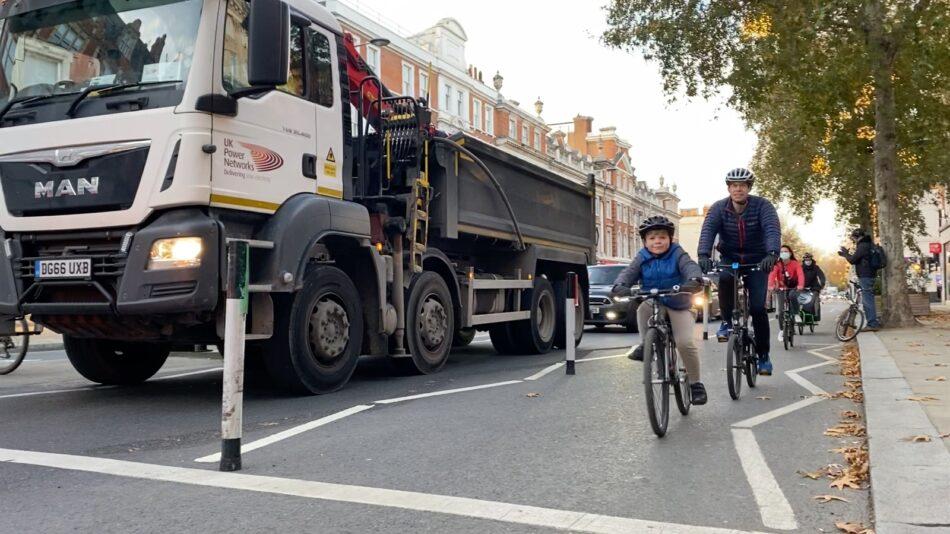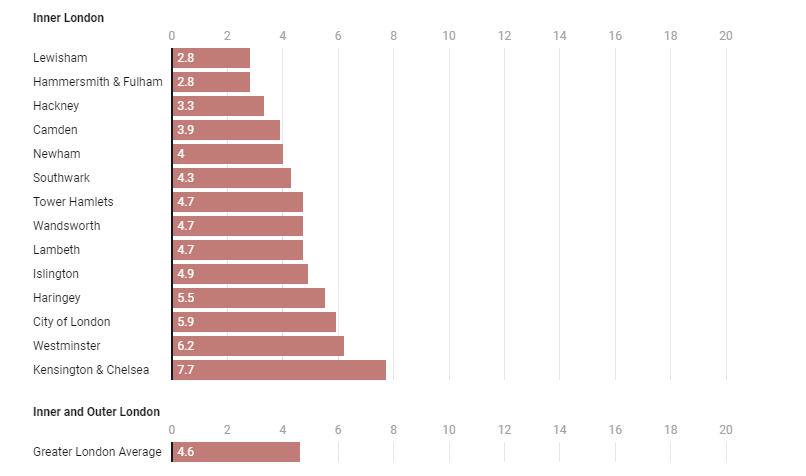

On Thursday 8 December, the Royal Borough of Kensington & Chelsea council (RBKC) will face a judicial review at the Royal Courts of Justice on their decision to remove trial protected bike lanes from Kensington High Street in December 2020.
The action is being brought by our friends at Better Streets for Kensington & Chelsea and their chair, Justin Abbott. The group argues that the decision to remove the bike lanes, before the scheme was fully installed and only seven weeks into their existence, was unlawful. The decision was made as an ‘emergency’, without a formal council meeting and no public consultation – apparently in response to noise from some disgruntled residents and businesses.
We welcome this public holding to account of a dangerously irresponsible local authority.
During their brief lifetime, the wand-protected cycle lanes along Kensington High Street saw a doubling in cycle trips to between 3,000-4,000 daily. This was within weeks of the scheme starting, and without fixes for two major junctions that TfL were set to carry out, if the scheme had been allowed to continue.
London Cycling Campaign (LCC) and Better Streets heard from many locals, including primary school teachers, who had not cycled for years but took up cycling because of the protected lanes. Then as soon as the lanes went, we saw a slew of collisions, a return of dangerous driving and just as much congestion as before, if not more, as Jeremy Vine’s videos illustrate, with a handful of parked cars replacing the cycle lanes.
Without the lanes, Kensington High Street is back to being a dangerous 1.5km gap in a much-needed strategic cycle route for thousands of Londoners trying to safely reach central London from the west. Cycleway 9 provides a safe route from Kew Bridge then stops at the borough boundary. Transport for London have long considered Kensington High Street one of its highest priority corridors for enabling cycling.
Indeed, a professional survey found that RBKC’s own residents support the cycle tracks, leading Mayor Sadiq Khan to say: “The ripping out of the new cycle lanes last year was not just an unacceptable waste of money, but went against what everyone could see: that the safe space for cycling on Kensington High Street was working. Cycling numbers were up, bus journey times down, yet the council were swayed by a few loud voices committed to the status quo.” Even consultants commissioned by the council to consider the future of the road are clear that cycle tracks are very much needed.
The cycle lane bollards were ‘adopted’ by local school children, but were removed anyway

In March of 2021, apparently to avoid legal action, the council held a meeting to reconsider their decision to remove the lanes. But no reconsidering took place – instead they opted for a study of “transport patterns in the post-Covid world” at an unspecified point in the future.
That study was finally published this autumn by the Centre for London, more than 18 months later. Its headline recommendation? Protected bike lanes on Kensington High Street. Despite commissioning the report, the council has thus far made no commitment to follow its recommendations and has kicked any action further into long grass, with the council website stating it will “add it to the workstream” of its Citizens Panel sometime in 2023. Rapid and bold action having declared a climate emergency? Hardly.
Road collision cyclist casualties in inner London boroughs 2021, Healthy Streets Scorecard

Whatever the judge rules on 8 December, RBKC has in our view not only failed to follow its own policies, or follow evidence, but wasted money and risked lives – all because of an irrational hostility to cycling schemes held both by a minority of noisy residents and many councillors themselves.
Why has this come to court at all? It didn’t need to. LCC has worked closely with Better Streets from its inception and throughout this whole saga. We’ve seen the many attempts the group has made to try and avoid reaching this point. They have expertly dismantled the arguments made by the council and built a 70+ strong coalition of institutional, stakeholder and business support for cycle tracks on Kensington High Street; and both publicly and behind closed doors, they have repeatedly begged the council to come to their senses.
RBKC has some of the most dangerous streets for walking and cycling in London (the Healthy Streets Scorecard graph above shows it has by far the worst cycling casualty rate in inner London). Yet the borough has repeatedly avoided spending money to address urgent safety problems on its roads, and instead lavished funds on fighting its own residents in court. As well as removing the Kensington High Street cycle tracks, the council has blocked or opposed other safety proposals, including Cycleway 10 on the extremely hostile Holland Park Avenue and Notting Hill Gate. This was an important safety scheme for walking as well as cycling, with several new pedestrian crossings planned.
The small group of volunteers at Better Streets for Kensington & Chelsea have shown outstanding courage and determination in holding to account the local authority that – as well as being one of the richest in the country – is arguably the most opposed to making walking and cycling safe on its streets. We hope for a positive outcome on 8 December for them, for all residents of RBKC and all Londoners who travel on this key route through the borough. But regardless of the verdict, LCC will continue to press for more and better cycling, walking, wheeling and car use reduction schemes across the capital and support groups like Better Streets acting to oppose inaction, delay and destruction of good schemes.
Support our work
LCC is highly effective because it's supported by 12,000+ members, giving us a powerful collective voice. If you cycle in London please consider joining today - you also get a host of member benefits.